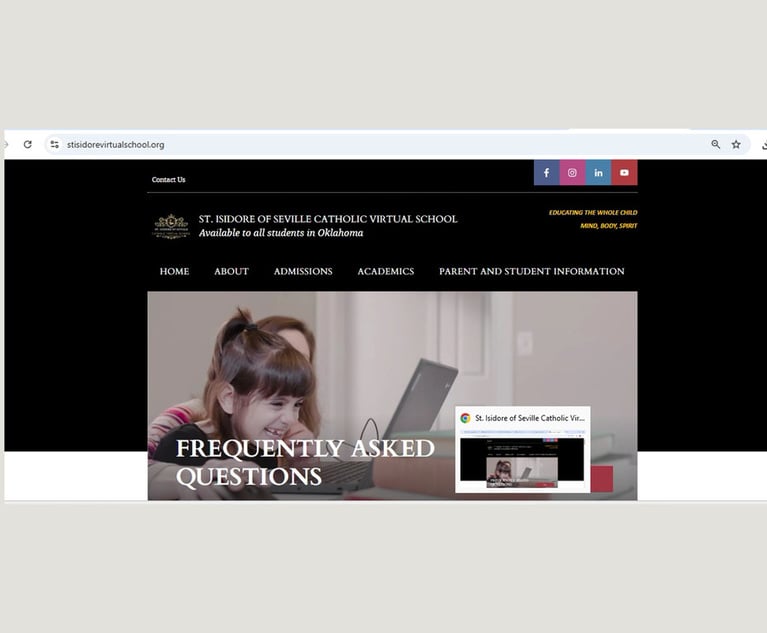Score! New Tool Helps Law Schools Compare GRE to LSAT
The technology allows users to plug in the various scores earned on the GRE and find out the comparable score on the Law School Admission Test.
March 15, 2018 at 02:37 PM
5 minute read
Seventeen law schools now accept the GRE in addition to the Law School Admission Test, but making sense of an applicant's GRE scores can be tough for admissions officers accustomed to dealing only with the law school-specific test.
Now, the maker of the GRE has created an online comparison tool that predicts the LSAT score an applicant would earn based on their GRE results. It's the second such tool offered by Educational Testing Service (ETS), which already has a tool to convert GRE scores into scores on the GMAT—the standardized test traditional used by business schools.
“The comparison tool helps the growing number of law schools accepting GRE scores to understand and appropriately interpret those scores in the context of LSAT scores to better inform their admissions decisions,” said Educational Testing Service vice president David Payne.
The comparison tool, which also can be used by individuals who have taken the GRE to see how they'd perform on the LSAT, is the latest move by ETS to take on the LSAT and expand into law school admissions. The testing organization has conducted GRE validity studies at numerous individual law schools, and in October released a study using data from 21 law schools that concluded the GRE is just as good as the LSAT in predicting first -year law school grades. (Kellye Testy, president of LSAT maker the Law School Admission Council, has raised concerns with the methodology of those validity studies.)
Meanwhile, the American Bar Association's Council of the Section of Legal Education and Admission to the Bar has yet to decide whether or not it will allow all schools to freely use the GRE, or prohibit its use altogether.
Law schools that have embraced the GRE say they are seeking to enlarge their applicant pools, and make it easier for those with backgrounds in science, technology, engineering and math (STEM) to apply. They also cite the accessibility of the GRE, which is offered throughout the year, as opposed to the LSAT's six annual administrations.
“We already know that GRE scores are a valid predictor of law school success for us, and we've seen other law schools perform similar evaluations and reach similar conclusions,” said Cary Cluck, assistant dean for admissions at the University of Arizona James E. Rogers College of Law, which in 2016 became the first law school to accept GRE scores. “Based on those foundations, and the work of ETS in the national validity study they conducted, the new GRE comparison tool for law schools gives us even more insight when it comes to evaluating applicants.”
On a practical level, predicting an applicant's LSAT score based on their score earned on the GRE is more complicated than a simple one-to-one comparison. LSAT scores are reported as a singe number between 120 and 180. But GRE scores are reported as three separate numbers: a verbal reasoning score and a quantitative reasoning score both ranging from 130 to 170, as well as an analytical writing score between 0 and 6.
The LSAT comparison tool uses only the verbal reasoning and quantitative reasoning scores, with the verbal reasoning carrying a heavier weight in the calculation. (The tool does not use the GRE's analytical writing score because the LSAT's writing sample is not scored and does not impact a taker's overall score.) For instance, a high score on the verbal reasoning portion of the GRE—170—but a middling score on the quantitative reasoning section—145—yields a predicted LSAT score of 166, which is relatively high. But when those scores are reversed on the GRE sections, the predicted LSAT score drops to 159.
The comparison tool can't offer an exact prediction of how GRE takers would score on the LSAT, however. ETS said there is a five-point margin of error on the LSAT scoring scale. That range “simply reflects the fact that a test taker would not score exactly the same each time they take a test or on every version of the test,” according to an ETS fact sheet about the comparison tool. But five points can represent a big difference among a school's applicant pool. At Harvard Law School, which was the second to begin accepting the GRE after Arizona, there's a five-point difference between the school's 75th LSAT percentile of 175 and its 25th percentile at 170, according the most recent data reported to the ABA.
“The GRE test can help institutions achieve their admissions goals because it is taken by over a half a million test takers annually from a broad array of backgrounds—including science and technology fields—that are relevant to the changing needs of the law profession,” Payne said.
This content has been archived. It is available through our partners, LexisNexis® and Bloomberg Law.
To view this content, please continue to their sites.
Not a Lexis Subscriber?
Subscribe Now
Not a Bloomberg Law Subscriber?
Subscribe Now
NOT FOR REPRINT
© 2025 ALM Global, LLC, All Rights Reserved. Request academic re-use from www.copyright.com. All other uses, submit a request to [email protected]. For more information visit Asset & Logo Licensing.
You Might Like
View All
LSU General Counsel Quits Amid Fracas Over First Amendment Rights of Law Professor
7 minute read
Pennsylvania Law Schools Are Seeing Double-Digit Boosts in 2025 Applications
5 minute read
What’s at Stake in Supreme Court Case Over Religious Charter School?

University of New Hampshire Law School Launches Specialized Health, Life Sciences Program
Trending Stories
- 1Second Judge Blocks Trump Federal Funding Freeze
- 2Crypto Hacker’s $65 Million Scam Ends in Indictment
- 3Trump's Inspectors General Purge Could Make Policy Changes Easier, Observers Say
- 4Supporting Our Supreme Court Justices in the Guardianship Part
- 5'Erroneous Rulings'?: Wilmer Asks 4th Circuit to Overturn Mosby's Criminal Convictions
Who Got The Work
J. Brugh Lower of Gibbons has entered an appearance for industrial equipment supplier Devco Corporation in a pending trademark infringement lawsuit. The suit, accusing the defendant of selling knock-off Graco products, was filed Dec. 18 in New Jersey District Court by Rivkin Radler on behalf of Graco Inc. and Graco Minnesota. The case, assigned to U.S. District Judge Zahid N. Quraishi, is 3:24-cv-11294, Graco Inc. et al v. Devco Corporation.
Who Got The Work
Rebecca Maller-Stein and Kent A. Yalowitz of Arnold & Porter Kaye Scholer have entered their appearances for Hanaco Venture Capital and its executives, Lior Prosor and David Frankel, in a pending securities lawsuit. The action, filed on Dec. 24 in New York Southern District Court by Zell, Aron & Co. on behalf of Goldeneye Advisors, accuses the defendants of negligently and fraudulently managing the plaintiff's $1 million investment. The case, assigned to U.S. District Judge Vernon S. Broderick, is 1:24-cv-09918, Goldeneye Advisors, LLC v. Hanaco Venture Capital, Ltd. et al.
Who Got The Work
Attorneys from A&O Shearman has stepped in as defense counsel for Toronto-Dominion Bank and other defendants in a pending securities class action. The suit, filed Dec. 11 in New York Southern District Court by Bleichmar Fonti & Auld, accuses the defendants of concealing the bank's 'pervasive' deficiencies in regards to its compliance with the Bank Secrecy Act and the quality of its anti-money laundering controls. The case, assigned to U.S. District Judge Arun Subramanian, is 1:24-cv-09445, Gonzalez v. The Toronto-Dominion Bank et al.
Who Got The Work
Crown Castle International, a Pennsylvania company providing shared communications infrastructure, has turned to Luke D. Wolf of Gordon Rees Scully Mansukhani to fend off a pending breach-of-contract lawsuit. The court action, filed Nov. 25 in Michigan Eastern District Court by Hooper Hathaway PC on behalf of The Town Residences LLC, accuses Crown Castle of failing to transfer approximately $30,000 in utility payments from T-Mobile in breach of a roof-top lease and assignment agreement. The case, assigned to U.S. District Judge Susan K. Declercq, is 2:24-cv-13131, The Town Residences LLC v. T-Mobile US, Inc. et al.
Who Got The Work
Wilfred P. Coronato and Daniel M. Schwartz of McCarter & English have stepped in as defense counsel to Electrolux Home Products Inc. in a pending product liability lawsuit. The court action, filed Nov. 26 in New York Eastern District Court by Poulos Lopiccolo PC and Nagel Rice LLP on behalf of David Stern, alleges that the defendant's refrigerators’ drawers and shelving repeatedly break and fall apart within months after purchase. The case, assigned to U.S. District Judge Joan M. Azrack, is 2:24-cv-08204, Stern v. Electrolux Home Products, Inc.
Featured Firms
Law Offices of Gary Martin Hays & Associates, P.C.
(470) 294-1674
Law Offices of Mark E. Salomone
(857) 444-6468
Smith & Hassler
(713) 739-1250









